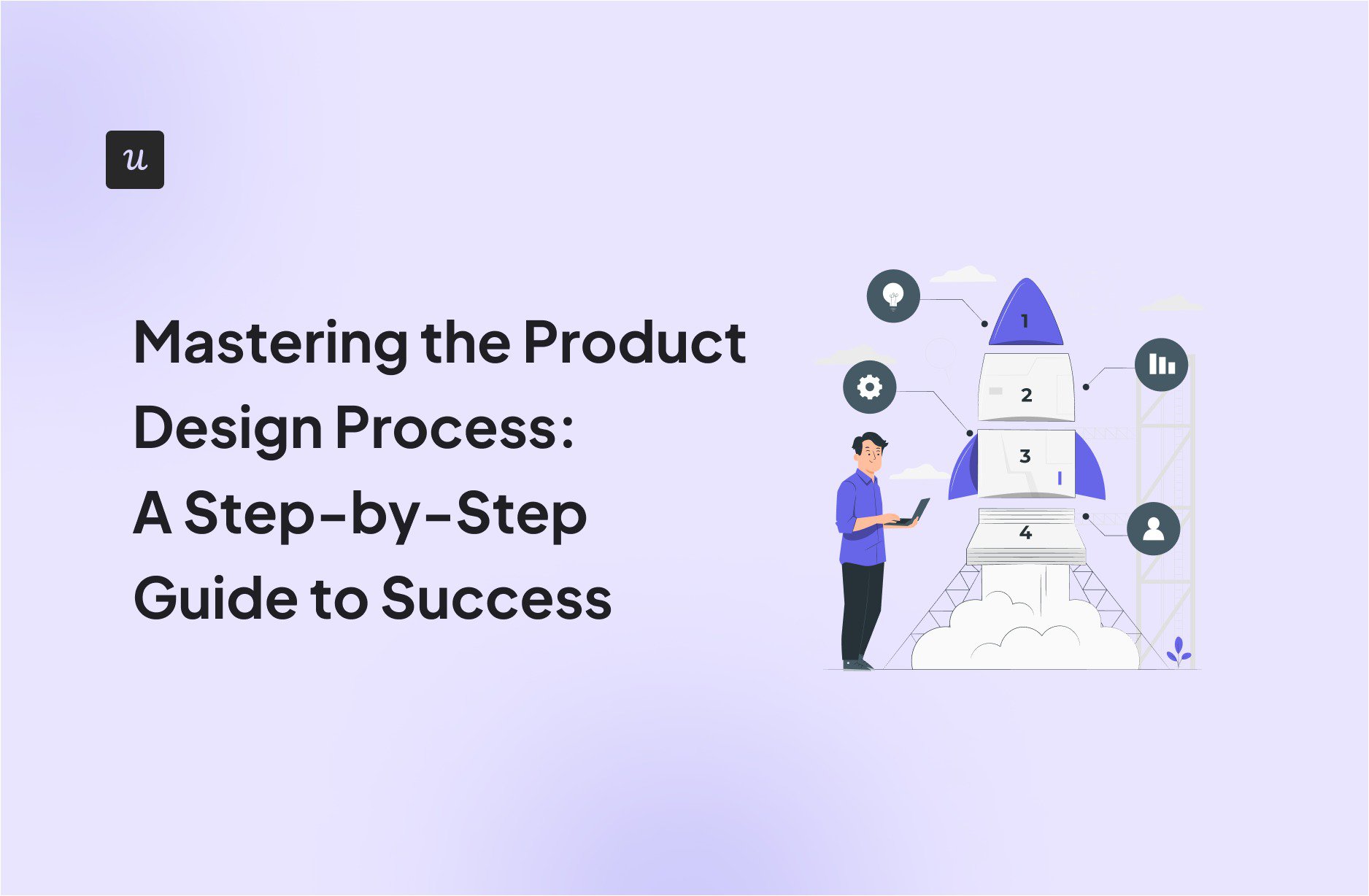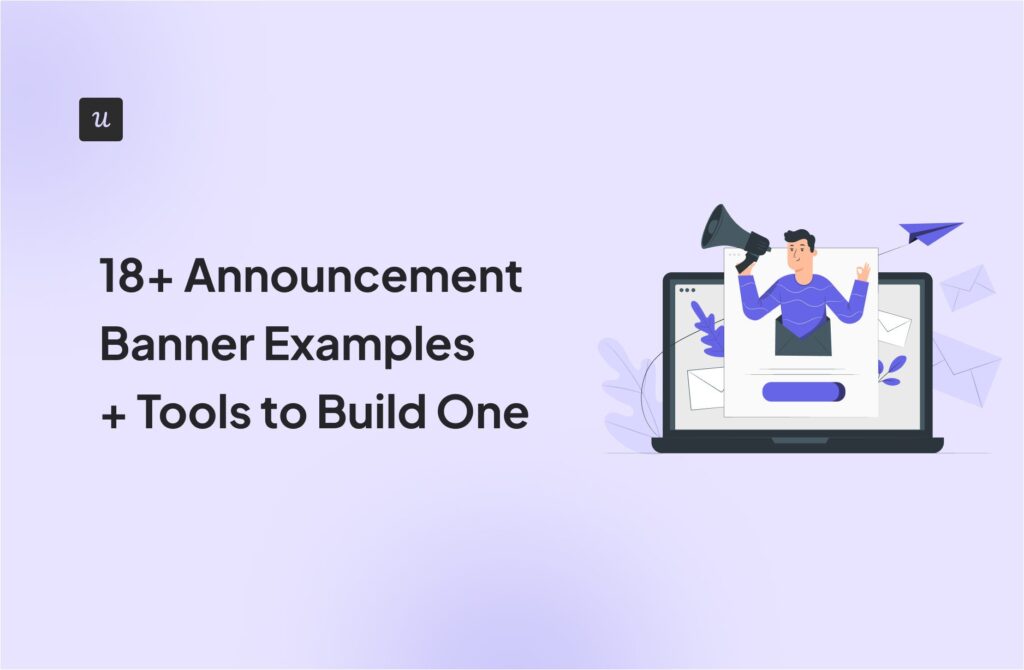
Mastering the Product Design Process: A Step-by-Step Guide to Success
Have you ever wondered about the product design process for companies like Slack, Loom, or ClickUp?
These companies not only follow a user-centric approach to product management. They also have a robust system to collect data, make decisions, build solutions, perform tests, and deploy new products on time.
That said, let’s look at what product design means, and explore each step of the process more deeply so you can streamline your workflow.
Try Userpilot Now
See Why 1,000+ Teams Choose Userpilot

What is product design?
Product design is the process of conceiving a product through design thinking. It involves researching data, identifying problems, generating ideas, developing prototypes, and testing products before they are released to the market.
The goal of product designers is to build a solution that meets user needs and solves real-life problems—making sure it penetrates the market.
How to get started with the product design process?
Each step of the product design process plays a crucial role in ensuring that the final product is both functional and desirable to users.
Let’s go over each of them one by one:
Step 1: Define value proposition and success criteria
The value proposition is a statement that explains why your product is the best choice for your target market.
A great value proposition should:
- Differentiate your product from other solutions in the market.
- Communicate the main benefit your product provides to users.
- Define the exact market segment for which this product is designed.
With this, you can determine your success criteria, which will determine whether you’ve reached your product’s goal. These criteria should be observable, objective, specific, realistic, and measured with one metric.
For instance, if your value proposition is “streamline your remote team’s workflow with our project management tool for agile frameworks”. Then, your success criteria could be to achieve a product adoption rate of 60%.
Step 2: Conduct user and market research
User research is essential for making informed decisions about product features, design, and positioning. It helps you identify opportunities, mitigate risks, and ensure your product aligns with market needs.
To do this, you can perform a competitive analysis to identify gaps in the market that your product can fill. You can also follow industry trends and emerging technologies to align your product with current market expectations and future demands.
As a result, you’ll be able to collect high-quality data that can orient your product development process.
Step 3: Understand user needs
Understanding your users is about empathizing with their pain points, goals, and needs.
For this, you need to collect detailed information about your target market. Who are they? Where do they work? What are their responsibilities and jobs to be done?
You can use social listening tools or browse relevant subreddits and forums to dig for comments about what type of features they’d want, their work routines, and what they wish to accomplish. You might as well reach out to people in your niche and ask questions.
This way, you can learn how to satisfy the needs of your target market, what expectations they have over products like yours, and the emotions they feel every day at work. And as a result, design a product that not only alleviates their pain points but also exceeds their expectations.
Step 4: Create user personas
Once you’ve collected data and developed a more accurate idea about your target customers, it’s time to segment your market into different user personas.
User personas are fictional representations of your ideal customers based on real data and research. They help you understand the needs, experiences, behaviors, and goals of your target audience—and design the best products for them.
For this:
- Curate the Data: Identify common characteristics and patterns among your users. This includes demographics, psychographics, behaviors, and pain points.
- Develop a Persona: Include information such as occupation, goals, challenges, JTBDs, and preferred communication channels.
- Build Scenarios: Create scenarios that illustrate how each persona would interact with your product in real-life situations.
For example, if you’re designing a product for product managers, you might include different pain points about “having to rely on engineers” and “struggling to track in-app behavior”. And then narrate how they’d interact with a no-code product analytics tool to solve those pain points.

Step 5: Sketch and prototype your product
In product design, a prototype is a working model of the product to test its functionality and usability.
It’s an essential part of the product design process since it allows you to explore how users will interact with your design and identify any issues before full-scale software development.
To do this:
- Create a basic sketch of your product. Focus on outlining the primary features and user interface elements, as well as exploring different possibilities and making rapid iterations.
- Use prototyping tools like InVision, Adobe XD, or Figma to create UIs, simulate user interactions, and test the flow of the interface.
- Test your prototype with your team or a select group of early adopters to see how functional it is. Fix mistakes and reiterate your product until you have a solid product.
For example, you could use Miro’s templates to create a wireframe of your product and a basic prototype.

Step 6: Perform usability testing
Usability testing is where you evaluate your product’s design and functionality with real users—allowing you to address any design flaws or usability issues before your product goes to market
For a smoother usability test, create specific tasks for users to complete using your product. These scenarios should reflect common and critical actions that users will perform.
Examples include signing up for an account, navigating through different features, or completing a purchase.
You can also choose between three different testing methods:
- Moderated Testing: Conduct sessions where a facilitator guides users through tasks and observes their interactions.
- Unmoderated Testing: Users complete tasks independently without a facilitator.
- Remote Testing: Conduct usability testing with users in different locations using screen-sharing tools and recording software.
Step 7: Refine and iterate
During usability tests, observe key user groups as they interact with your product and take note of any difficulties they encounter.
You can ask open-ended questions to gain insights into their thought processes and preferences. Also use tools like screen recordings and surveys to gather comprehensive feedback.
This way, you can make continuous improvements based on testing results—ensuring that your product evolves to better meet user needs and expectations.
Once you’ve performed multiple iterations of your product, it’s time to start planning your launch process.
Step 8: Launch the product
A well-executed launch plan can significantly impact your product’s initial adoption and long-term success.
For this, coordinate the timing and logistics of your product launch to ensure a smooth rollout. This involves categorizing your launch plan tasks into three phases:
- Pre-Launch Activities: Build anticipation through teaser campaigns, pre-launch sign-ups, and beta testing.
- Launch Day Activities: Ensure your product is ready for users, your website is optimized, and your customer support team is prepared for increased activity.
- Post-Launch Activities: Follow up with users through emails and social media to gather feedback and maintain engagement.
Remember, a successful product launch will give enough momentum to expand brand awareness, bring customers through WOM, and become a name in your market.
Step 9: Perform post-launch evaluation
Post-launch evaluation involves assessing your product performance after it has been launched. This step is crucial for understanding how well your product meets user needs and identifying areas for improvement.
For this, you need to start tracking:
- User Feedback: Continuously collect feedback from users through in-app surveys, user interviews, and direct communication.
- Performance Metrics: Key metrics to monitor include User Engagement, Customer Satisfaction, Conversion Rates, and Retention Rates.
- Bugs and Issue Resolutions: Identify and address any technical issues or bugs reported by users.
If you’re a non-technical product manager, you can use a tool like Userpilot to create and trigger in-app surveys, measure product performance, and collect bug reports from users.

Step 10: Continuously improve the product
Once the product has launched, making constant improvements to your product is necessary to keep momentum, stay relevant in the market, make customers feel heard, and cultivate product growth.
Ultimately, this is where the real game starts. You should follow a solid workflow loop where you can receive feedback, implement improvements, and expand your MRR from loyal customers and organic growth.
This process involves:
- Product Updates: Regularly release updates that address common pain points, improve usability, and add valuable functionality.
- Feedback Loops: Establish a systematic approach for collecting, analyzing, and reciprocating your feedback with users.
- Agile Development: Adopt agile methodologies to quickly implement changes, test new features, and iterate based on user feedback.
- Benchmarking and Market Analysis: Benchmark your product against software industry standards and stay informed about emerging trends.
For instance, you can leverage a product management tool like Userpilot to trigger follow-up questions to NPS detractors, understand what’s going wrong with their experience, and focus on improving that.

Best practices when designing a product
Here are some essential best practices to follow when designing your product:
Ensure your product idea is well-defined and resonates with potential users
“Everything begins with a great idea.” Earl Nightingale.
A well-defined product idea should address a specific problem and resonate with potential users. Otherwise, its presence in the market can result in indifference and flop.
Your product idea should meet three requisites:
- Clarity: Ensure your product idea is easy to understand and communicate.
- Relevance: Validate that it solves a real problem for your target users.
- Differentiation: Highlight what makes your product unique compared to existing solutions.
For example, Loom’s idea is to allow people to record your screen quickly and on demand. The idea is clear, it’s relevant to any person running a remote team, and the product is very different from what the market had to offer at the time.
Use storytelling to connect emotionally with your audience
Storytelling can make your product more relatable and engaging by connecting with users emotionally.
That said, it is important to craft compelling narratives that illustrate how your product can improve users’ lives or solve their problems.
For this, your narrative must have:
- Structure: Your stories should follow a clear pattern that resonates with human psychology.
- Authenticity: Ensure your stories are genuine and reflect real experiences.
- Consistency: Every part of your brand (marketing, development, operations, etc) should work according to your product’s narrative.
- Proof Point: Your narratives must be based on something real to resonate.
Maintain transparent communication between the organization
Transparent communication ensures everyone involved in the product design process is aligned and informed.
This not only fosters collaboration but also helps avoid misunderstandings or misaligned expectations.
For this:
- Keep Regular Updates: Keep all stakeholders updated on the progress and any changes.
- Open Channels: Encourage open communication and feedback within the design team.
- Documentation: Maintain clear and accessible documentation of the product design process and decisions.
Conclusion
Mastering the product design process is essential for creating successful digital products.
By following a structured approach and incorporating best practices, you can ensure your product meets user needs and stands out in the market.
So if you need to collect feedback, report bugs, create key user flows, and iterate your product experience without coding—you can always book a Userpilot demo to streamline your design process yourself!



![10 Free Product Roadmap Templates You Need in 2026 [+Free Download] cover](https://blog-static.userpilot.com/blog/wp-content/uploads/2026/01/10-product-roadmap-templates-you-need-in-2026-free-download_d8269f0b0b9749f6ad7b519ab7ac1833_2000-1024x670.png)



